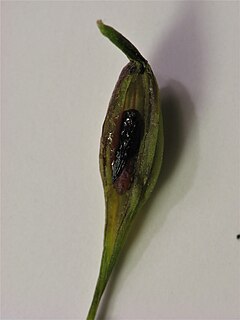
A midge is any small fly, including species in several families of non-mosquito Nematoceran Diptera. Midges are found on practically every land area outside permanently arid deserts and the frigid zones. Some midges, such as many Phlebotominae and Simuliidae, are vectors of various diseases. Many others play useful roles as prey for insectivores, such as various frogs and swallows. Others are important as detritivores, and form part of various nutrient cycles. The habits of midges vary greatly from species to species, though within any particular family, midges commonly have similar ecological roles.

Cecidomyiidae is a family of flies known as gall midges or gall gnats. As the name implies, the larvae of most gall midges feed within plant tissue, creating abnormal plant growths called galls. Cecidomyiidae are very fragile small insects usually only 2–3 mm (0.079–0.118 in) in length; many are less than 1 mm (0.039 in) long. They are characterised by hairy wings, unusual in the order Diptera, and have long antennae. Some Cecidomyiids are also known for the strange phenomenon of paedogenesis in which the larval stage reproduces without maturing first. In some species, the daughter larvae consume the mother, while in others, reproduction occurs later on in the egg or pupa.

Aprostocetus is a genus of hymenopteran insects of the family Eulophidae. The genus was erected by John O. Westwood in 1833. This very large group of parasitoid wasps has a global distribution.

Contariniatritici is a small dipterous insect of the family of gall gnats. It depredates wheat, to which it is nearly as destructive as the famous and closely allied species, the Hessian fly. As is typical for agricultural pests, the species is known by a number of common names, including wheat fly, lemon wheat blossom midge, wheat blossom midge, wheat yellow blossom midge, yellow wheat blossom midge, and yellow wheat gall midge.

Contarinia quinquenotata is a small midge which infests the flower buds of Hemerocallis, causing the buds to swell, remain closed and rot. It is a pest in several parts of the world. It is known by the common names of daylily gall midge and hemerocallis gall midge.

Contarinia nasturtii, the swede midge, is a small fly, the larvae of which infest brassica plants, causing twisting and distortion of the leaf stems and foliage including death of the growing point in seedlings, or damage to developing flower heads. It is native to Europe and Turkey, and has been introduced into North America where it is regarded as an invasive species.

Contarinia is a genus of midges, small flies in the family Cecidomyiidae.
Neolasioptera allioniae is a species of gall midges, insects in the family Cecidomyiidae.

Cecidomyiini is a tribe of gall midges in the family Cecidomyiidae. There are at least 220 described species in Cecidomyiini.
Taxodiomyia taxodii, the cypress leaf gall midge, is a species of gall midges, insects in the family Cecidomyiidae.

Taxodiomyia is a genus of cypress gall midges, insects in the family Cecidomyiidae. There are at least 3 described species in Taxodiomyia.

Asphondyliini is a tribe of gall midges in the family Cecidomyiidae. There are about six genera and at least 100 described species in Asphondyliini.

Caryomyia is a genus of hickory gall midges in the family Cecidomyiidae. They are often known as the hickory gall midges since most species feed on various species of hickory. There are at least 30 described species in Caryomyia.

Rhopalomyia pedicellata is a species of gall midges, insects in the family Cecidomyiidae.

Oligotrophini is a tribe of gall midges, insects in the family Cecidomyiidae. There are at least 20 genera and 300 described species in Oligotrophini.
Neolasioptera is a genus of gall midges, insects in the family Cecidomyiidae. There are at least 130 described species in Neolasioptera.

Contarinia negundinis, known generally as boxelder gall midge, is a species of gall midges in the family Cecidomyiidae. Other common names include the boxelder bud gall midge and boxelder leaf gall midge. It is the only North American species that enters diapause during the pupal stage of development.
Contarinia citrina is a species of gall midge in the family Cecidomyiidae.
Contarinia virginianiae, known as chokecherry midge or chokecherry gall midge, is a species of gall midges in the family Cecidomyiidae. It's host is the chokecherry Prunus virginiana.
Geromyia penniseti, the millet grain midge, is a species of gall midge in the family Cecidomyiidae. It is found in Africa and South Asia. During the rainy season, it feeds on the developing grains of pearl millet plants.













